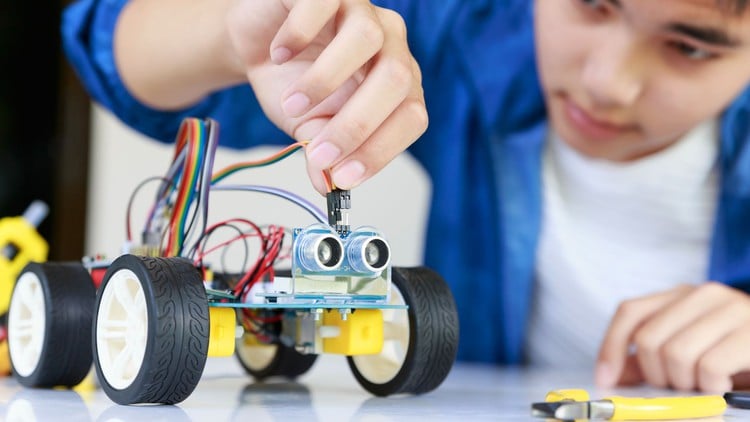
Learn To Create Arduino UNO Based Obstacle Avoiding Robot Car & RC-Control
⏱️ Length: 1.9 total hours
⭐ 4.24/5 rating
👥 38,555 students
🔄 May 2022 update
Add-On Information:
Note➛ Make sure your 𝐔𝐝𝐞𝐦𝐲 cart has only this course you're going to enroll it now, Remove all other courses from the 𝐔𝐝𝐞𝐦𝐲 cart before Enrolling!
- Course Overview
- Embark on a practical robotics journey building an intelligent mobile platform with Arduino UNO. This course demystifies embedded systems, guiding robot construction for autonomous navigation and remote control.
- Gain essential hardware-software interaction understanding, from sensor input to motor output. This program equips you with fundamental skills for developing responsive automation systems.
- Leveraging the popular Arduino ecosystem, this curriculum offers a structured path to mastering key robotic functionalities. A 4.24/5 rating from 38,555 students confirms its effectiveness.
- Discover the complete process of prototyping a robotic solution: component selection, circuit integration, power management, and operational logic for reliable function.
- Requirements / Prerequisites
- Enthusiasm for technology and problem-solving, plus basic computer literacy, forms the primary prerequisite. No prior programming or electronics experience is necessary.
- Access to a personal computer (Windows, macOS, or Linux) with Arduino IDE installed and a stable internet connection is required.
- Participants must acquire specific hardware: an Arduino UNO, various sensors, motors, and an RC module; a detailed list will be provided.
- Willingness for hands-on assembly and systematic troubleshooting is crucial. Robotics demands patience and analytical thinking to debug software and hardware.
- Skills Covered / Tools Used
- Master embedded C/C++ programming for Arduino, focusing on hardware interaction, digital/analog I/O, and structured code for real-time control.
- Develop expertise in sensor integration and data interpretation, learning to interface ultrasonic distance sensors and process data for autonomous obstacle avoidance.
- Acquire proficiency in DC motor control techniques, effectively managing motor speed and direction using motor driver ICs for precise robot locomotion.
- Understand and implement wireless communication protocols for RC control, programming transmitter and receiver modules for reliable command links.
- Gain practical experience in circuit assembly and breadboarding, applying best practices for component placement, wiring, and power distribution for stable operation.
- Utilize the Arduino IDE as your core development environment, proficiently writing, compiling, uploading, and debugging code, including serial monitoring.
- Hone critical hardware and software debugging skills, systematically identifying and resolving issues from wiring errors to logic flaws.
- Explore fundamental robot locomotion and basic kinematics, understanding how differential drive systems enable movement, steering, and turning for controlled navigation.
- Benefits / Outcomes
- Independently design, assemble, program, and test your own basic mobile robotic platforms, building confidence in engineering challenges.
- Achieve practical understanding of embedded systems architecture, recognizing direct control software has over physical hardware, valuable for IoT and automation careers.
- Enhance your problem-solving and critical thinking skills through hands-on troubleshooting of real-world hardware and software integration issues.
- Create a compelling project portfolio entry with a functional obstacle-avoiding robot car and an RC-controlled system, demonstrating practical capabilities.
- Gain foundational knowledge to innovate and create custom robotic solutions, translating ideas into working prototypes that respond intelligently to surroundings.
- Become equipped to leverage the extensive Arduino community resources, libraries, and global support network for future projects.
- PROS
- Accessible Entry: Uses beginner-friendly Arduino UNO, simplifying complex robotics.
- Project-Focused: Builds a tangible, functional robot, ensuring practical skill acquisition.
- Dual Control: Covers autonomous avoidance and remote (RC) control for versatile understanding.
- Time-Efficient: At 1.9 hours, delivers maximum learning impact in minimal time.
- Highly Rated: 4.24/5 from 38,555 students confirms effective content.
- Cost-Effective: Inexpensive Arduino components provide an affordable robotics gateway.
- Up-to-Date: May 2022 update ensures content aligns with current practices.
- Transferable Skills: Programming and hardware integration applicable to other electronics and IoT.
- CONS
- Limited Advanced Depth: The short 1.9-hour duration restricts delving into highly advanced robotics theories, complex algorithms, or extensive hardware customization.
Learning Tracks: English,IT & Software,Hardware
Found It Free? Share It Fast!